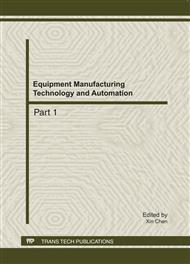p.2436
p.2440
p.2444
p.2449
p.2454
p.2461
p.2466
p.2473
p.2477
Flexible Polishing Machine with Dual Grinding Heads for Aeroengine Blade and Blisk
Abstract:
The blade and blisk manufacturing includes polishing process when the surface roughness and size requirement of profile are disqualified after milling process. This polishing process is mainly carried out manually by skilled workers or NC machines. However, the existing polishing technology always leads to surface quality instability and inconsistency because of the complex free-form surface of blade and blisk. Therefore, in this paper, based on the research of polishing requirements and methods of blade and blisk, an automatic 6-axis polishing machine was proposed in order to enhance surface quality. And then, a polishing mechanism was designed using flexible technique to make the polishing tool accommodate surface waviness which was produced in milling process. In addition, the working principle and control method of flexible polishing mechanism were studied. Finally, the polishing test results of blade and blisk showed that the profile error was about 0.06mm and the surface roughness was less than Ra0.4 after automatic polishing. Compared with the manual polishing process, the automatic polishing technology not only increased the polishing efficiency and quality stability, but also reduced labor intensity largely.
Info:
Periodical:
Pages:
2454-2460
Citation:
Online since:
August 2011
Authors:
Keywords:
Price:
Сopyright:
© 2011 Trans Tech Publications Ltd. All Rights Reserved
Share:
Citation:


